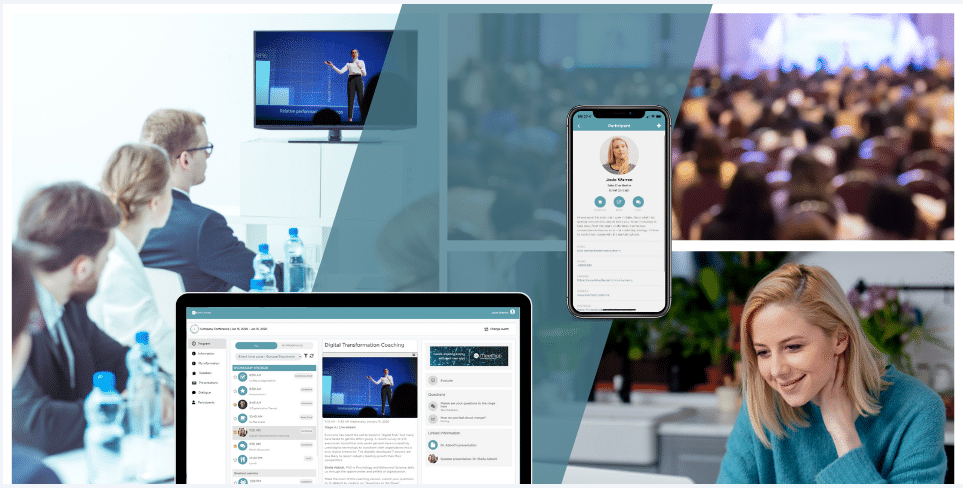
Want to start using Ventla app today?
Get in touch“Should we arrange an in-person or a virtual event?” At this point, virtual is the way to go. Sooner or later, however, it will be time to make steps back towards planning on-site events. This shift will likely happen gradually and even in a COVID-secure future, there will be a new need to create open participation from both on-site hubs and from home.
There are many benefits to hosting a hybrid event. In this article, we answer the most common questions we receive and share some key insights on how to make sure everyone gets as much out of your hybrid conference as they would from an on-site event.
A hybrid event is a meeting, event, or conference where you combine a physical meeting with a digital event experience, allowing participants to join on-site, via hubs, or from home.
Essentially, you take the event that you would have held on-site – with the same participants, program, content, interaction, etc. – and adapt it so that it becomes accessible and engaging for all participants, regardless of whether they are on site or participating remotely.
Unlike a virtual event, where all participants follow the event remotely via smartphone or computer, a hybrid event has participants who are present on-site and via hubs. This means that you now have two participant groups to relate to – your on-site audience and your remote audience – creating a need to adapt the content and interaction to suit both groups.
If you want to give your participants the opportunity to meet up and participate digitally, you need to organize hubs. This may mean that you book conference rooms at local offices or conference facilities where you show the livestream on the big screen. For those participants who can and would rather meet up than participate from home, it is an excellent way to participate remotely as it contributes to both increased engagement and interaction. This is comparable to watching a football match either by yourself or in a group.
An important thing to consider when arranging a hybrid event with hubs, is the need to tie the hubs together and give the participants a feeling that they are part of something bigger. Just like at a “regular” conference, digital events provide the opportunity to build community an important quality that needs to permeate through both content and digital interaction. An event app is unbeatable here, as it makes it easy for everyone – organizers as well as on-site and digital participants – to communicate, interact, and create “togetherness.”
Organizing a hybrid event is beneficial for those who would like to hold an in-person event, but for various reasons, cannot gather all participants in one place. This could be due to government directives preventing large groups or due to participants who feel hesitant to travel and gather in groups.
A hybrid event is much more scalable and cost-effective than an on-site event. In addition, it is easier to collect data and statistics about participants’ ideas, opinions, and engagement when you have a virtual venue. Furthermore, the message you want to convey can easily reach everyone, wherever they are.
A common mistake when creating a hybrid event is thinking that it will be enough to just film the stage to allow remote attendees to participate. However, as mentioned above, on-site participants and those who participate from home or a hub have different needs. To create a unified event experience, you must take both audiences into account to be successful.
A digital event is more than just a livestream, similar to how an in-person event is more than just a stage. To succeed with your hybrid event, it is more important than ever to engage and interact with your participants, promote networking, and share content that is accessible to both your remote audience and your on-site participants. It is also vital to keep the production value in mind when creating hybrid events. Any glitches in terms of lighting, audio, or internet connection can make or break the whole event experience for the participants.
An important goal of your hybrid event should be to create a digital experience that engages all participant groups equally. To succeed, you need to adapt the content. The first thing to remember is that the remote participants, who are simply watching a screen, do not have the same “attention span” as your on-site attendees. Therefore, we recommend that you:
The key to engaging an audience that participates from a distance is to create an experience that is as near to an in-person event as possible. To succeed with a hybrid event, both audiences need to be afforded the same opportunities to interact and network with one another. Using an event app becomes a valuable tool, as it provides this level of interaction and gives everyone the same opportunity to:
A tip to creating community between remote participants, those gathered in hubs and those joining from home, is to direct questions specifically to them, to set up polls and let participants vote “hubwise,” or to let each hub hold their own program item.
If networking is one of your event goals, you need to create networking experiences that provide the same opportunities for both on-site and remote participants to connect with one another. With an event platform, this is simplified by allowing participants to be grouped automatically based on their interests, industry, and more. Groups can be made up of a mix of on-site and remote participants, which allows the opportunity for interaction between the groups. All attendees can further mingle with one another through virtual meeting rooms. Event organizers can encourage this interaction by creating networking challenges which are communicated through push notifications or by creating friendly competitions through gamification tools.